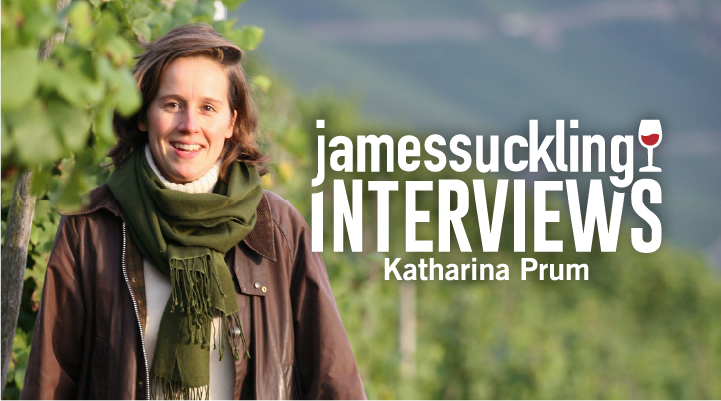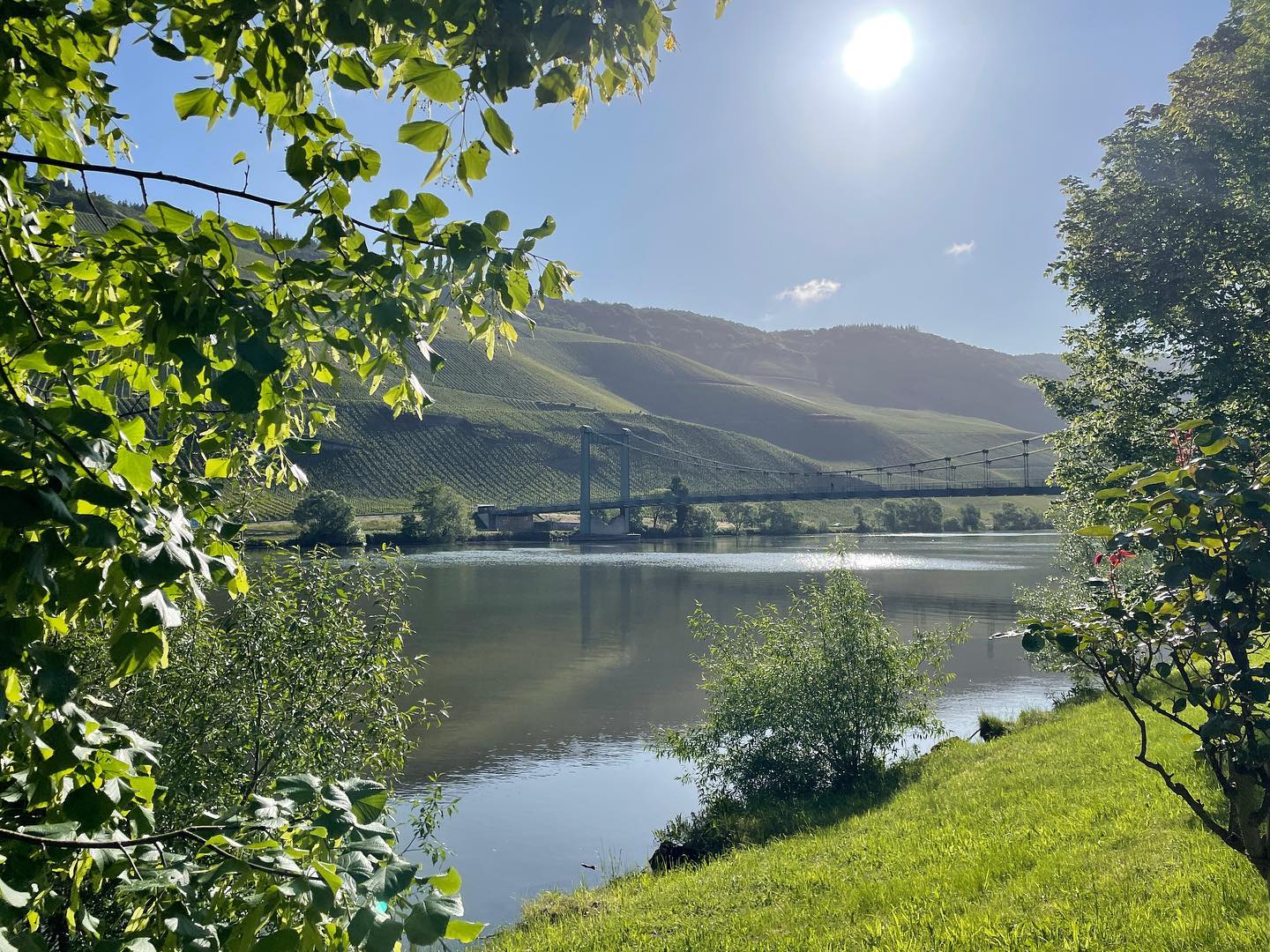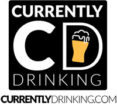[ad_1]

JamesSuckling Interviews options revolutionary and influential vineyard house owners, winemakers and trade notables representing the brand new technology that’s shaping tastes, traits and strategies within the higher wine world.
________________________________________________
The Joh. Jos. Prum vineyard in Germany’s Mosel Valley has been placing top-tier German riesling on the worldwide wine map for greater than 100 years, setting continued excessive requirements for freshness, finesse and ageability.
Taking on the property in 1969, Manfred Prum championed a benchmark model greatest showcased with a decade – and sometimes far more – years in bottle. After leaving a profession in legislation in 2023 and becoming a member of her father full time on the Center Mosel property within the village of Wehlen, Katharina Prum has continued the legacy as main winemaker.
JamesSuckling.com’s Susan Kostrzewa talked with Katharina about how she retains a cool head within the face of jarring local weather surprises; understanding the distinction between sustainable and natural farming; the rising world appreciation for cellar-worthy white wines and the way wine connects and “brings cultures collectively.” The interview has been edited for size and readability.
Let’s begin by speaking in regards to the challenges of the 2022, which was one of many hottest and driest on document for the Mosel, and the 2023, which was particularly moist, with excessive rainfall working the danger of infections and mould within the winery. How did you navigate these vintages and the way do you assume your expertise now in winemaking has helped you navigate what you’re experiencing with these extremes?
I feel expertise helps as a result of it lets you be calm. I grew up on the [Joh. Jos. Prum] property, within the constructing itself, surrounded by the entire manufacturing and with the data that you just can not predict issues, that you must face challenges.
In these days, the primary concern was get sufficient ripeness. The Mosel is a cool local weather, and nonetheless is comparatively cool. That often meant to my father that we would have liked to attend so long as potential in selecting to get ripeness, but in addition take a excessive threat, as a result of the longer you wait and the extra you go into October and November, the climate bought extra unstable.

However I feel the sorts of challenges have modified extra just lately. The 2022 classic for me was essentially the most excessive expertise as a result of we had this large dryness. Dryness was one thing that I grew up with and our slope the place we develop wine has a unbelievable water provide, so lack of water was not beforehand a priority. I spotted this isn’t essentially the very fact any longer in ‘22.
From April to early September – on this predominant ripening interval, spring, after bud break to simply earlier than harvest – there was virtually no rain. Our response was to fastidiously observe the vineyards and to chop off lots of grapes, and within the excessive section of harvest to do a giant quantity of inexperienced harvest, which is often one thing we don’t love to do in that quantity as you may simply deliver imbalance to the vine.
I’m satisfied it was the one probability to ensure the ripeness of the classic and likewise save the long-term well being of the vines. 2023 was not as difficult as a result of this extra rain is one thing we’ve recognized prior to now. However what is obvious is that there are much more extremes.

Within the face of those extra unpredictable and difficult situations within the Mosel, making exact choices requires not solely experience, however the level-headed persistence you simply talked about. Do you see this as a problem for producers within the area who is likely to be extra reactive and threat averse?
Nearly all of growers right here have grown up with wine, so most estates have a protracted viticultural historical past. Nevertheless, there are additionally fairly a couple of new folks within the area, which I feel is unbelievable as a result of it additionally brings new vitality and new views. Most of them have labored in wineries earlier than after which determined to determine their very own estates. However I feel in case you resolve to work with nature, and also you wish to make your passion a career, then typically it may be difficult. And so they usually get annoyed in a short time.
For me, it helped that I began to work with my father within the 2003 classic, which was fairly an excessive yr. It was extremely popular – a lot hotter within the south of Europe, however nonetheless comparatively scorching right here additionally. I keep in mind some growers virtually had been panicking – youthful growers who had been much less skilled – they usually stopped my father and stated, “What will we do?” As a result of sugar ranges went up, acidity ranges went down. My father had already carried out many vintages and had a protracted perspective.
That helped me to study, to even be calm. In 2022, I noticed some examples the place skilled growers didn’t take into account the consequence of inexperienced harvest sufficient. And this was a catastrophe. In the event you had too-high yields in that yr, the vines simply stopped growing and the grapes I noticed in some parcels I couldn’t even have harvested since you couldn’t do a correct wine with it. However all of us study yearly and there are at all times new points we add to our expertise.

Some producers have talked in regards to the silver lining that local weather change has introduced, regardless of its apparent negatives. Do you’re feeling your wines have been positively affected by these hotter and drier situations?
The local weather warming has positively helped as a result of prior to now, as I discussed, we didn’t get sufficient ripeness. That was an issue till the early ‘90s. At the moment, we’ve got these extremes and we’ve got to face them, and whereas it’s much less secure, if you understand how to take care of it, you’ll be able to produce a greater vary of vintages; a wider vary of wines with totally different ripeness ranges, and so forth.
We have now not had any unhealthy vintages for the reason that early ‘90s. Humidity is usually a downside, however that has at all times been an issue, particularly throughout harvest. So that you simply must be tremendous selective. However the truth that we’re in a position to get sufficient ripeness yearly is a giant distinction and a constructive change.
What makes your rieslings so contemporary and first on their launch?
There are lots of totally different points. First, you must deal with your vines nicely all year long and attempt to do the most effective within the given state of affairs. You can not predict the long run; we will perhaps foresee the forecast for the following two or three days, however no extra.
We have now to work with all of the expertise we’ve got collected prior to now and observe and react. Then it’s important to reap every parcel on the most ultimate time. Possibly you harvest a complete parcel in a single go, or perhaps in 5 goes. After all, it’s 100% guide selecting, so that you additionally must have an skilled group. The way to harvest, choose, that is essential.
After which I feel within the cellar it’s simply doing as little as potential. When the grape is harvested, we would like our aim to be 100% reached and we strive to not lose any share after that. We by no means add cultivated yeast. We ferment in stainless-steel, which is tremendous impartial. We don’t strain the wine, so the fermentation would possibly take every week, a month, or a yr. We let this explicit tank resolve how lengthy it takes.

In your cellar, what’s the fixed ambient temperature, and do you ever provide excursions there?
The temperature varies as a result of it’s not a temperature-controlled cellar. It’s under the property constructing, within the earth which breeds pure chilling. In winter it will get perhaps down to five levels Celsius (41 Fahrenheit) or so. In summer time it will get nicely over 10. So perhaps 12, perhaps 13, 14.
On excursions, no, as we don’t have a present cellar. It’s a working cellar that grew over the a long time. My father took some folks to the cellar years in the past. They had been tremendous upset as a result of they’d seen lovely cellars elsewhere. And the home itself is a good looking constructing. You will have an concept of what cellar you count on and ours has the tanks, the bottled wines, and there’s no order as a result of it was developed step-by-step.
Your previous in addition to ungrafted vines are a singular characteristic of your property. How do your previous vines help in administration of the altering local weather?
About 90 p.c of our vines are ungrafted, which is a really excessive share. And it’s a really uncommon factor as a result of, as you recognize, most areas worldwide can not have ungrafted vines. However the Mosel, with its slate soils, is likely one of the few areas, few soils that may have ungrafted vines.
Our previous vines we admire an increasing number of, particularly coming again to the 2022 classic and years when we’ve got these extremes, as a result of the previous vines have deeper roots and may deal with these extremes significantly better than younger vines.
After we did the inexperienced harvest in 2022 we particularly needed to take care of these vines that had been of their first years, which luckily will not be a giant portion for us. They had been actually struggling. They had been filled with vitality after which they’d no water. If we had not reacted in any respect, they may have died.
You’ve been open about working sustainably within the winery however not committing to natural or biodynamic practices. Are you able to speak extra about that?
Natural and sustainable are for me two very various things. Sustainable means actually working as near and for the great of nature. Not simply in your piece of land, however for the ecosystem.
Natural for me is a distinct factor. As in life, there is no such thing as a black and white and natural will not be essentially higher for nature. For instance, you should spray far more usually, which implies extra CO2 emissions. We’re partly natural, simply to see additionally how the vineyards react to it, how the soils react to it, however not absolutely dedicated.
The subject I wrestle lots with is the subject of copper, as a result of copper [used in fungicide] is a heavy metallic. It by no means disappears from the soil. There are therapies which have been allowed in natural rising prior to now and for my part, for political causes and never for scientific causes, they’ve been forbidden.
Now there are discussions to permit them once more, which reveals it’s not one thing at all times confirmed scientifically or determined by scientific causes. I feel sadly as a grower we’ve got to place far more vitality into figuring out what’s greatest for nature and what’s the greatest for our soils.

So it’s extra of a private course of and ongoing evolution.
I feel in all of the little steps you must make your individual determination and you should really feel good with it. And typically you don’t really feel 100% good with it, however you’re feeling in the long run it’s the higher answer.
One facet, for instance, is utilizing herbicides. We don’t try this. However after all it means that you’ve got folks that work actually arduous in very, very steep slopes and must take away the unhealthy weeds by hand. And typically I ask myself, is it actually accountable to do it?
It goes past the winery. All of us discovered extra just lately what a big effect the load of the bottle has on the worldwide CO2 emission. I at all times had an consciousness, within the final two or three or years I learn some articles and noticed some statistics, and was shocked with how massive the affect is.
I’m glad that historically essentially the most authorized inexperienced bottle we use is kind of mild in weight. We had one bottle that was heavier and whereas lovely, we stopped utilizing it as a result of it was perhaps 20 p.c heavier.
Ageability is a trademark of Mosel riesling, and your wines are thought of among the many prime tier of cellar-worthy whites on the earth. Do you assume the fashionable client is changing into more and more respectful of the necessity to maintain advanced white wines? How have you ever appealed to shoppers who won’t perceive this?
Rising up, we by no means opened an excellent younger bottle within the household only for enjoyable. I keep in mind my first go to to the U.S., and I used to be fully shocked that individuals thought they needed to drink the wine instantly. Worldwide, I feel that’s altering.
Once I do tastings, seminars, masterclasses, I at all times say to think about or deal with these wines as you’ll a pink wine that you just wish to age. However I don’t say to not open a ‘22 and even just-bottled ‘23 Kabinett. On a scorching summer time day within the Mosel Valley, it’s tremendous enjoyable to have this and revel in this, however you get a very totally different expertise in case you let that wine age 5, 10 or extra years and you may age a Kabinett – the entry stage of the predicate wines – for 20 or 30 years with none downside.

There are extra folks worldwide that admire rieslings. The collector’s scene is changing into wider. It’s not simply Europe and the U.S. There are lots of wine collectors and wine lovers in Asia. In Australia, for instance, I feel the data is rising. I’ve seen that individuals who admire riesling have a tendency to not stick with only one area or producer and wish to strive extra issues.
Additionally as I discussed, meals pairings. Ten to fifteen years in the past in France for instance, there have been usually few non-French wines on restaurant menus, and now, prime eating places in Paris are asking, can we’ve got a couple of bottles of one thing aged as a result of we wish to present it to folks? These requests present extra consciousness. It’s sluggish however I feel it’s growing in an excellent course.
What do you take into account to be new areas of alternative for Prum and for the area?
We produce 100% riesling and have determined to not change that. We nonetheless really feel it’s absolutely the ultimate grape selection for our comparatively cool local weather. There are different, hotter areas that produce unbelievable rieslings, so that provides me hope to see what occurs there. There are regional producers who plant syrah and chardonnay, and guests to the vineyard have stated they tried their first syrahs from the Mosel and had been very positively shocked. So I feel general there are alternatives for brand new grape varietals now.
Past varietals, I’m very optimistic for our area so far as worldwide gross sales and recognition for our wines are involved, as a result of I feel this model of wine is one thing that appeals to an increasing number of folks. The comparatively low alcohol ranges that we’ve got here’s a essential facet.
‘I’m very optimistic for our area so far as worldwide gross sales and recognition for our wines are involved’
It was virtually an impediment prior to now as a result of, as you recognize, there have been waves when folks had been seeking to 16-plus p.c on the label. And I keep in mind 20 years in the past once I was discussing with a U.S. importer what to say on the label in addition to the authorized situations you must placed on it. We prompt together with the comparatively low alcohol content material they usually stated, no, no, don’t try this. That is when Californian wines had been very a lot in vogue.
Individuals at the moment are far more acutely aware about alcohol ranges. Additionally, the model, particularly the pradikat wines that we produce, are unbelievable for meals pairing. And I feel this subject of wine and meals pairing is far more vital than prior to now. Persons are far more adventurous. And naturally, we’re a distinct segment worldwide. I feel to extend the area of interest a bit bit and create extra consciousness – together with for the lesser-known growers, is a giant alternative.
The put up JamesSuckling Interviews: Katharina Prum appeared first on JamesSuckling.com.
[ad_2]


